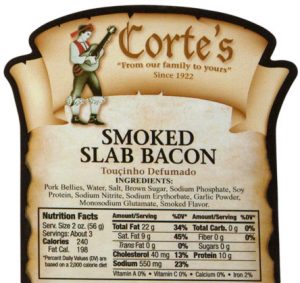The Food and Drug Administration (FDA) implemented a number of changes to food labeling requirements. These new nutrition labels for 2020 requirements include the addition of added sugars and elimination of several vitamins. Companies exceeding $10 million in revenue must comply with the new changes by January 1st, 2020. However, companies who land below that revenue mark have until January 1st, 2021 to comply. Although, it is better to begin prepping and changing your labels now while you have the time. If a company were to leave it for too long, then forget about it, fines will be coming your way!
Why the FDA Implemented these New Nutrition Labels for 2020 and What are the Changes
 One may wonder why the changes were so necessary for the FDA to push them through for 2020. Upon visual inspection, one can simply deduce a few differences from that of the older labels. For example in the new label: calories are highlighted in bold and in larger font, “added sugars” became their own category, and the footnote has been changed regarding the advice and daily values being based on a 2,000 calorie diet. Let’s go through each update and discover the “why” behind each update.
One may wonder why the changes were so necessary for the FDA to push them through for 2020. Upon visual inspection, one can simply deduce a few differences from that of the older labels. For example in the new label: calories are highlighted in bold and in larger font, “added sugars” became their own category, and the footnote has been changed regarding the advice and daily values being based on a 2,000 calorie diet. Let’s go through each update and discover the “why” behind each update.
Added Sugars
A new category has appeared on the updated FDA food label: added sugars.
The FDA’s logic is that it becomes increasingly difficult to stay within the daily recommended caloric range if more than 10 percent of one’s diet is derived from added sugars.
Daily Value Percent Changes
According to the FDA’s new 2020 rules, the daily value percentage of any vitamin or mineral is not to exceed 100 percent. In addition, Vitamins A and C have been removed due to a lack of relevance considering the rarity of having a deficiency. Replacing those two vitamins are potassium and iron.
This change reflects the fact that the average American does not consume sufficient amounts of either nutrient on a regular basis.
Dietary Fiber and Sodium
The changes also include the updated daily recommended values for dietary fiber and sodium. Sodium had a recommended DV (daily value) of 2400 mg per day. The new value is now 2300 mg. In addition, dietary fiber changed from daily recommendations of 25 g to 28 g.
These changes stem from a larger movement per the WHO (World Health Organization) in a global effort to improve heart health worldwide. Dietary fiber contributes to overall digestive health. Foods containing significant amounts of dietary fiber tend to be heart healthy and micronutrient dense. Thus, it’s in line with the effort to improve public health.
Changes to Footnote of Nutrition Labels
The very bottom of the label was redone to draw attention to the meaning behind daily value percentages. The new text explains the daily value percentage as it pertains to meeting nutrient need according to the advisement of a 2000 calorie diet.
Emphasis previously was placed on the issue of caloric consumption based upon one’s personal needs.
If you have been thinking about updating your labels with new images or graphics to make them look fresh, now may be the time to do both!
Updating your look and nutrition labels now will help make sure your labels are not only compliant but also save you the cost and time of making multiple changes later.